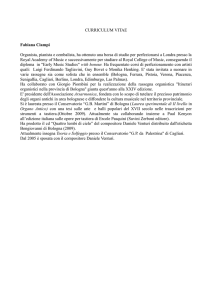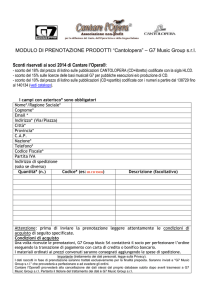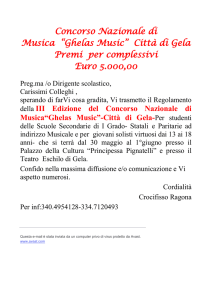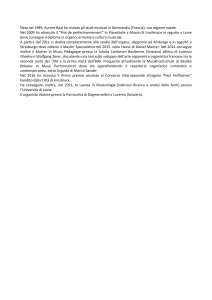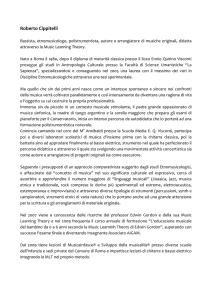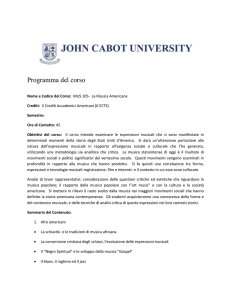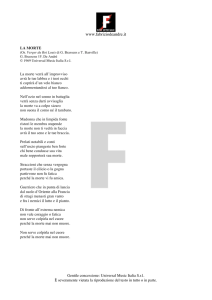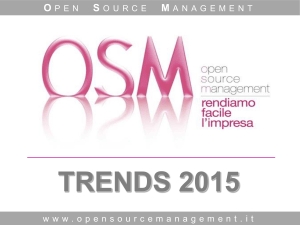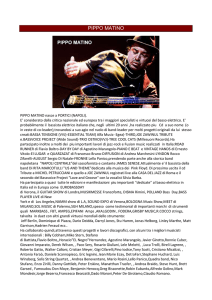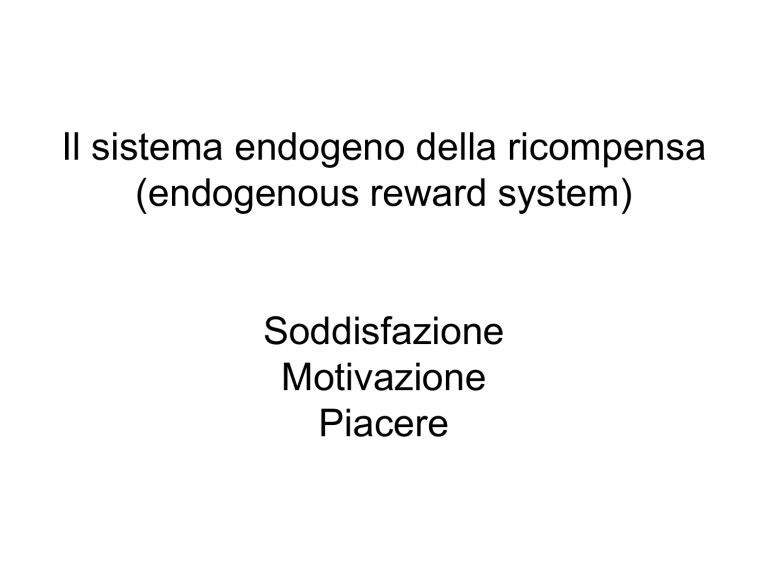
Il sistema endogeno della ricompensa
(endogenous reward system)
Soddisfazione
Motivazione
Piacere
motivazione La forza che induce un individuo a mettere in atto un determinato
comportamento diretto a uno scopo. Per motivazione si intende quindi uno
stato interno dell’individuo che attiva, dirige e mantiene nel tempo il suo
comportamento verso una meta. Senza motivazione, non potremmo far fronte a
nessuna ‘sfida’ che la vita ci propone.
I due tipi di meccanismi motivazionali.
La motivazione si riferisce a quegli aspetti del comportamento che sono in
rapporto con i nostri bisogni e desideri.
La motivazione può aver origine dalla necessità di soddisfare bisogni di base
fisiologici, quali mangiare, bere, accoppiarsi, o dal desiderio di ottenere un
oggetto, conseguire un obiettivo, perseguire un ideale.
È possibile quindi distinguere tra motivazioni fisiologiche, innate, che vengono
in genere attivate da alterazioni di condizioni fisiche interne, ed elementi
motivazionali acquisiti con l'esperienza individuale e sociale.
Questi due elementi interagiscono continuamente: uno stato motivazionale
fisiologico, per es. la fame che porta alla ricerca di cibo, potrebbe interagire con
un altro stato motivazionale, per es. il portare aiuto a un amico, nell’attivare e
dirigere il comportamento di un individuo.
Interazioni tra i due sistemi motivazionali.
Oltre che dalla presenza di deficit fisiologici, il
comportamento motivato emerge da processi che
richiedono la valutazione delle azioni utili allo scopo, la
valutazione delle loro possibili conseguenze o del
ricordo delle loro conseguenze, se già messe in atto,
degli stati motivazionali fisiologici e degli stati
motivazionali acquisiti, e delle necessità percepite in altri
individui.
Tali processi richiedono le funzioni esecutive della
corteccia prefrontale e la combinazione di diversi
sistemi, in particolare di quelli che consentono a un
individuo di assegnare un valore a cose, persone,
eventi.
Tali sottosistemi includono strutture sottocorticali, quali il
nucleus accumbens, l’amigdala, l’ippocampo,
l’ipotalamo, e strutture corticali quali la corteccia
prefrontale, orbitofrontale, la corteccia cingolata e il polo
anteriore dei lobi temporali.
Il sistema dopaminergico modula molte tra queste
regioni ed è quindi incluso nel cosiddetto sistema
endogeno della ricompensa.
Core
Il sistema è più complesso ….
PFC prefrontal cortex
NAc nucleus accumbens
VP ventral pallidus
AMG amigdala
LH lateral hypothalamus
VTA ventral tegmental area
LDTg laterodorsal tegmental nucleus
I sistemi di neuromodulazione
Connettività del
sistema endogeno
della ricompensa.
Proiezioni noradrenergiche alla corteccia prefrontale
Studi nell’animale e nell’uomo hanno mostrato
che la ricompensa aumenta il rilascio di
dopamina bel nucleo accumbens, aumentando
l’attività del medesimo (da Olds e Milner, anni ’50,
alle neuroimmagini).
Ricompense “innate”
Cibo
Acqua
Riparo
Caldo
Compagno
Dalla risposta alla ricompensa “innata” alla
risposta ad un oggetto o ad una azione ad essa
associata:
L’apprendimento strumentale o condizionamento
operante
La bellezza come “ricompensa”?
Ricompense “individuali”
(non innate e universali)
Knut K. W. Kampe, Chris D. Frith, Raymond J. Dolan & Uta Frith
Making eye contact enhances the appeal of a pleasing face,
irrespective of gender.
Nature, 2001.
Faces were counterbalanced for head
position, sex and, for non-eye-contact
images, gaze direction (right or left).
During each scanning session, subjects
were presented with 2 runs of 80 faces and
40 scrambled control faces in a
randomized, event-related design (new
image every 3.5 s; presentation time, 1.2 s,
with intervening scrambled images).
No task was required from subjects while
they viewed these images, but to secure
and test their attention, six target images
(faces with closed eyes) were included, to
which subjects were asked to respond by
pressing a button. In statistical analysis,
these latter images were modelled as
events of no interest and excluded from
further evaluation.
After scanning, subjects rated the
attractiveness of the 40 faces on a scale
from 1 to 10. There were no significant
differences between ratings by male and
female subjects, or between ratings on
male and female faces.
Eye gaze directed to the
observer enhances pleasantness
of a face.
This is correlated with activity in
the reward system.
Striato ventrale
When eye gaze is directed at a subject, the degree of
attractiveness of individual faces correlates positively with brain
activity in the ventral striatum.
(in yellow areas in which activity surpasses the threshold of P = 0.05).
Perceived attractiveness of an unfamiliar face
increases brain activity in the ventral striatum
(dopamine) of the viewer when meeting the
person's eye.
Depending on the direction of gaze,
attractiveness can thus activate dopaminergic
regions that are strongly linked to reward
prediction, and influence attractiveness
judgement itself.
Salimpoor et al., 2011, emotional reaction to music
Using the neurochemical specificity of [11C]raclopride positron
emission tomography scanning, combined with
psychophysiological measures of autonomic nervous system
activity, it was found that endogenous dopamine is released in
the striatum at peak emotional arousal during music
listening.
To examine the time course of dopamine release, the authors
used functional magnetic resonance imaging.
Most people agree that music is an especially potent pleasurable
stimulus that is frequently used to affect emotional states.
It has been empirically demonstrated that music can effectively
elicit highly pleasurable emotional responses and previous
neuroimaging studies have implicated emotion and reward circuits
of the brain during pleasurable music listening, particularly the
ventral striatum, suggesting the possible involvement of
dopaminergic mechanisms. However, the role of dopamine has
never been directly tested.
217 individuals responded to advertisements requesting people
who experience chills to music; after five rounds of screening, the
final group included eight participants. Individuals provided ten
pieces of instrumental music to which they experience intense
pleasure and “chills” without restrictions to the genre of music,
which included classical, folk, jazz, electronica, rock, punk, techno
and tango.
Correlation between reported
chills and psychophysical
measurements
The mean intensity of chills
reported by each participant
during the PET scanning
session was significantly
correlated with
psychophysiological
measurements that were also
acquired during the scan.
These are indicative of
increased sympathetic nervous
system activity, suggesting that
the intensity of chills is a good
marker of peak emotional
arousal
Evidence for
dopamine release
during pleasurable
music listening.
Statistical parametric
maps (t statistic on
sagittal, coronal and
axial slices) reveal
significant (P < 0.001)
[11C]raclopride
binding potential (BP)
decreases bilaterally in
the caudate, putamen
and NAcc (white
arrows) during
pleasurable compared
with neutral music
listening, indicating
increased dopamine
release during
pleasurable music.
(a) [11C]raclopride PET scan results were spatially conjoined with the fMRI results by creating a mask of significant dopamine
release overlayed on BOLD response t maps during each condition. (b) Hemodynamic responses and dopamine activity were
maximal in the caudate during anticipatory phases, but shifted more ventrally to NAcc during peak emotional responses.
(c) Percent signal change in BOLD response relative to the mean was calculated from the peak voxel of the caudate and NAcc
clusters based on the [11C]raclopride PET data. Voxels showing maximum dopamine release in the caudate and NAcc were
identified and percent BOLD signal change was calculated during the fMRI epochs associated with peak emotional responses; values
were interpolated for each second preceding this response for each individual, up to 15 s, which was defined as the anticipatory
period. There is increased activity during anticipation (A1-A15) and decreased activity during peak emotional response (C1-C4) for
the caudate, but in NAcc a maximum during peak emotional responses. The mean signal for neutral epochs for the NAcc and
caudate clusters are also plotted for reference, as are the 5 s preceding the anticipation epochs.
These results provide the first direct evidence that the
intense pleasure experienced when listening to music is
associated with dopamine activity in the mesolimbic
reward system, including both dorsal and ventral
striatum. Notably, the anticipation of an abstract reward can result in
dopamine release in an anatomical pathway distinct from that associated with
the peak pleasure itself.
This phylogenetically ancient circuitry has evolved
to reinforce basic biological behaviors with high
adaptive value.
However, the rewarding qualities of music listening are
not obviously directly adaptive.
+


